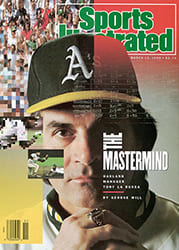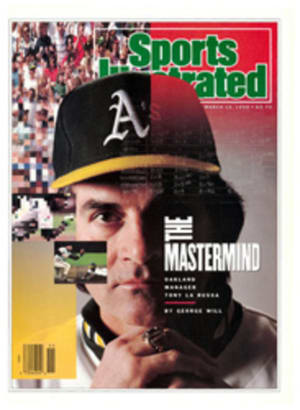
WAITING FOR HIS CHANCE
Britt burns hobbled from the pitcher's mound to first base on a ground ball to the right side. This was just a routine spring training drill, but each awkward, seemingly painful step Burns took threatened to end with his collapse. Minutes later, as he surrounded a well-placed bunt, he looked like an oversized vehicle doing a three-point turn in an alley. "I see you, Hopalong," pitcher Ron Davis yelled at him jokingly.
Burns laughed. "That's only the first nickname," he would say later. "There will be more."
Burns smiles now because four years ago he could barely put on his right shoe without help—or without crying. These days he can run without pain, though when he does he looks like a cross between Fred Sanford and the Tin Man. He's pitching again despite a right leg that he says, "is about 65 years old. But I have the heart of a three-year-old, so that compensates for it. And my arm is as good as ever."
Burns was once one of the better pitchers in baseball, a burly, 6'5", hard-throwing lefthander who won 70 games for the Chicago White Sox from 1980 through '85. However, in spring training of '86, after being traded to the New York Yankees, he was forced out of the game at age 26 by osteoarthritis, a progressive degeneration of the joints that's rare in someone so young. Massive surgery on his right hip that same year alleviated much of the pain, and hunting elk in the mountains of Colorado helped restore his strength and his will. Last week found him in the Yankees' minor league camp, in Tampa, attempting a comeback at 30. Burns says he expects to be a member of New York's starting rotation when the season begins.
Spring training is about players like Burns. It's about long shots seeking to beat the odds, like former Los Angeles Raider tight end Todd Christensen, who recently hit a home run on the first pitch he saw at an Oakland Athletics' mini-camp before his tryout fizzled. It's about aging veterans looking for a final shot, like Baltimore Oriole minor leaguer Daniel Boone, 36, who last pitched in the majors in 1982, but has a new knuckleball to show off. It's about fresh-faced kids hoping to get noticed, such as 22-year-old Steven (Turk) Wendell, who refuses to wear socks under his stirrups when he pitches in the Atlanta Braves' minor league camp.
Spring training is about rookies trying to nail down roster spots. Third base jobs could be won by Mike Blowers of the Yankees, Robin Ventura of the White Sox and Carlos Baerga of the Cleveland Indians. Carlos Quintana needs a million grounders to learn how to play first base for the Boston Red Sox. Baltimore's Ben McDonald has pitched only nine innings in his minor league career, but a good spring might guarantee him a spot in the Oriole rotation.
Now, who knows? These are the guys who need all six weeks of spring training to make their cases, and these are the ones most affected by baseball's lockout. "It could screw up a lot of guys," says Ken Rowe, the Yankees' Triple A pitching coach.
Consider the case of first baseman-DH Randy Bass, 35, who was invited to Baltimore's major league camp on a look-see basis. A two-time Triple Crown winner in Japan, Bass was released by the Hanshin Tigers in May 1988 and sat out last season. Now, at his 350-head cattle farm in Lawton, Okla., he awaits Baltimore's call to report.
"This is a once-in-a-lifetime deal," says Bass. "At this age, you'll never get another chance. I'd like to play in the major leagues again, just to see what it's like after so many years. But it doesn't look like I'm going to get that chance."
Meanwhile, Burns is trying to put a positive spin on the situation. As one of many Yankee nonroster invitees, he has been allowed to work out during the lockout. "I might be the only guy ready to pitch come April," says Burns. "The lockout might be a break in my favor."
If anyone deserves a break, Burns does. After his second and last outing of the '86 exhibition season, a miserable three-inning stint, he wept in the clubhouse, "not so much because of the pain, but the realization that my career was over." He underwent 4½ hours of surgery that May. Then came 11 days in the hospital and six months on crutches. Following a year and a half of doing what he calls "literally nothing," Burns bought a ranch in Collbran, Colo., and spent a lot of time there after separating from his wife. His time in the Rockies helped ease the pain of a difficult divorce that was finalized last year. He had saved his baseball earnings wisely, so he didn't need a job. He hunted, mostly elk, mostly alone.
"I'd hike up hills and down hills," he says. "I was getting around pretty good. One day it sort of clicked. I thought to myself, Think about what you just did."
In June 1989, Burns threw for the first time in nearly two years. His left arm was sound. When he decided to make his comeback, he felt he owed the Yankees first crack. Owner George Steinbrenner said O.K.; after all, the Yankees used 16 starting pitchers last year—Britt Ekland might have gotten a shot if she threw hard enough.
In Collbran, Burns met Mary Cunningham, 25, a master's candidate at Colorado State. They became good friends. "Mary is a flake," he says, "but she thinks I'm a fruitcake when I tell her I'm going to play for the Yankees. She thinks I'm this washed-up ex-jock. I don't think she believes I can do this."
Few ballplayers have come back from a four-year absence; fewer still have tried it after severe physical debilitation. "We're not looking at whether his stuff is good." says George Bradley, the Yankees' director of player personnel. "It's too early for that. We want to see if he can do everything without pain. We're a long way away from giving a yes or no on him. But we don't have anything to lose. And neither does Britt."
Burns is upbeat every minute. Because his fastball isn't what it once was, he knows he will have to sink the ball now and change speeds more. Still, he says, "I've pitched to imaginary hitters a million times in my mind the last four years, throwing changeups on 3 and 1—something I never did before. The way I felt out there in batting practice yesterday, I feel I can win with that stuff. Just give me the ball and get out of my way. Nothing else can stimulate me like that, nothing else can motivate me like that. Mary Cunningham, eat your heart out."
Willpower aside, there's still the matter of his 65-year-old leg. "I don't think it's a big deal," says Burns, who had surgery on his left leg when he was 12, after a growth spurt robbed his left hip of its range of motion. "My hip joints have never been normal. You deal with them. I've got four scars down my right leg and two down my left. But I see a zipper on a pitcher's elbow, and man, that gives me the creeps."
Every day after working out, Burns returns to his small room at the Days Inn, a mile from the Yankees' minor league complex, and waits for the real competition to arrive in Florida. "I just love the game, I love throwing a baseball," says Burns. "I miss it. I miss the camaraderie, I miss the guys. There's nothing else to replace it. It's not just the money, either. It's so much more. You get out in the real world and decide that the real world is, well, brutal."
As Burns has struggled to reenter the baseball world, baseball has been battling with itself across a negotiating table out in the real world. For those like Burns who wait to prove themselves, the waiting has been, well, brutal.
PHOTO
CARYN LEVY
PHOTO
CARYN LEVY
Hip surgery has left Burns with "a 65-year-old leg," but he says his arm can still cut it.

